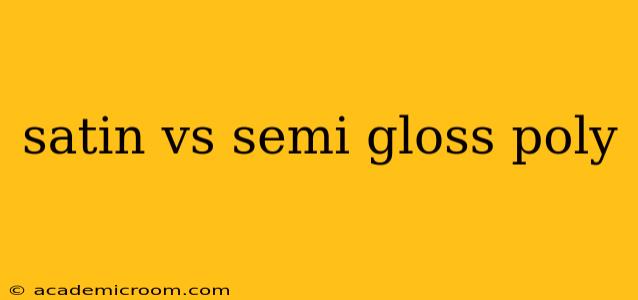Choosing between satin and semi-gloss polyurethane can feel overwhelming, especially for DIY enthusiasts. Both offer durable protection, but their sheen levels and practical applications differ significantly. This comprehensive guide will help you understand the key distinctions to make the best choice for your woodworking or painting project.
What is the Difference Between Satin and Semi-Gloss Polyurethane?
The primary difference lies in the sheen level. Semi-gloss polyurethane has a more noticeable, reflective shine, while satin polyurethane offers a softer, less reflective look. This difference affects not only the aesthetics but also the practicality and durability in certain applications.
Think of it this way: semi-gloss is like a polished mirror reflecting light, while satin is like a softly brushed piece of metal, reflecting light more subtly.
What is Satin Polyurethane Best For?
Satin polyurethane is a versatile choice suitable for a wide range of projects. Its subtle sheen minimizes the appearance of imperfections, making it ideal for:
- Furniture: Satin's understated elegance works well on furniture pieces where you want a touch of shine without overpowering the design. It's particularly good for pieces with intricate details or carvings, as it won't highlight minor flaws.
- Cabinets: Similar to furniture, satin polyurethane on cabinets provides a sophisticated look without being too flashy. It offers good protection while remaining relatively low-maintenance.
- Trim work: For interior trim and molding, satin creates a classic and refined finish. It's a good balance of durability and aesthetics.
- Doors: Satin provides good protection against everyday wear and tear on interior doors while maintaining a pleasant appearance.
What is Semi-Gloss Polyurethane Best For?
Semi-gloss polyurethane is a more durable and easier-to-clean option, making it a practical choice for:
- High-traffic areas: Its harder finish provides superior protection against scratches and scuffs, making it suitable for floors, kitchen cabinets in high-use areas, and children's furniture.
- Bathrooms and kitchens: The high gloss and easy-to-clean properties make semi-gloss the better option in moisture-prone areas. It's more resistant to water damage and stains.
- Exterior applications: Semi-gloss can provide better UV protection and weather resistance compared to satin. However, it's crucial to choose a polyurethane specifically formulated for outdoor use.
- Projects needing frequent cleaning: The easier clean-up aspect makes it ideal for areas prone to spills or sticky fingers.
Which Polyurethane Finish is Easier to Clean?
Semi-gloss polyurethane is easier to clean. Its harder, more reflective surface is less porous, making it less susceptible to absorbing dirt and grime. Cleaning spills and smudges is significantly simpler than with satin polyurethane.
Which Polyurethane is More Durable?
Semi-gloss polyurethane is generally considered more durable than satin. The harder finish resists scratches and abrasions better, making it more suitable for high-traffic areas and surfaces that experience frequent use.
Which Sheen Level is Best for Hiding Imperfections?
Satin polyurethane is better at hiding minor imperfections due to its softer sheen. The subtle reflection minimizes the visibility of surface irregularities, whereas semi-gloss can emphasize flaws.
Can I Use Polyurethane on Different Types of Wood?
Yes, both satin and semi-gloss polyurethane can be applied to various types of wood. However, proper preparation is essential regardless of the chosen sheen. Sanding the wood to a smooth surface before application is crucial for optimal adhesion and a professional-looking finish.
Is There a Difference in Application?
The application process for both satin and semi-gloss polyurethane is largely the same. Whether you're using a brush, roller, or spray gun, the technique remains consistent. The key is to apply thin, even coats and allow ample drying time between coats.
Choosing between satin and semi-gloss polyurethane ultimately depends on your project's specific needs and aesthetic preferences. Consider the level of durability, ease of cleaning, and desired visual appeal when making your decision. Remember to always follow the manufacturer's instructions for best results.
